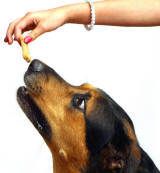Using Food
to Remind and Reward
Introduction
Using food as a reward is when you allow
the dog to eat the food treat in exchange for a correct behavior
executed quickly and correctly in response to your request.
Using food as a
paycheck
First,
discover what foods your dog likes. Finding the
right food is like identifying a paycheck that will
provide sufficient motivation. Try a variety of
foods such as boiled chicken, types of cheeses,
hotdogs, liverwurst, cheerios, cat kibble, or frozen
canned dog food that is firm enough to cut into
small pieces. Individually wrapped slices of cheese
can be divided into tiny pieces while still wrapped
in plastic, minimizing waste and mess.
|
The goal is to keep treats
small - the size of a
cheerio - and tasty to avoid
upsetting the nutritional
balance of the daily
consumption of food. |
Guidelines for selecting food
rewards
High protein treats may affect brain
chemistry and help the dog relax. Use caution with treats that
contain artificial colors or preservatives as some dogs will be
allergic or sensitive to these ingredients. Ask your veterinarian
for advice if your dog has allergies or is taking medicines,
especially if your dog is taking monoamine oxidase inhibitors (MAOI).
Dog biscuits generally do not provide sufficient motivation and take
too long to consume (an unwanted distraction) during a training
session. However, for some dogs, treats that are too desirable can
also be distracting. The dog may become too stimulated to think.
Treats should be tiny enough to prevent the dog from getting too
full, fat, or bored. If the dog stops responding to one kind of
treat, try another type. Treats need to be less than 10% of the
dog's daily ration of a well-balanced diet. Do not use
chocolate as it can be toxic to dogs.
Using rewards effectively is an art
Rewarding dogs with food treats is
an art. To prevent the dog from lunging for the
food, keep the prepared treats in a little cup or
plastic bag behind your back. Keep the hand that has
the treat behind your back so that the dog does not
focus on the food hand. You can then move that hand
to teach the dog where to look such as moving the
food next to your eyes, then smiling big if the dog
gives you eye contact.
The food treat must be small enough that the dog's
attention is not focused on a slab of food but
rather your cues. Treats need to fit in a closed
palm and not visible when held between the thumb and
forefingers. (The dog will be able to smell
the treat in your hand!) When presenting the dog
with the treat, start by moving the back of your
hand to the dog, then turn your wrist to open your
hand.
When using food
as a training tool, it is helpful if the dog is
hungry to increase the dog's attention and
motivation to learn.